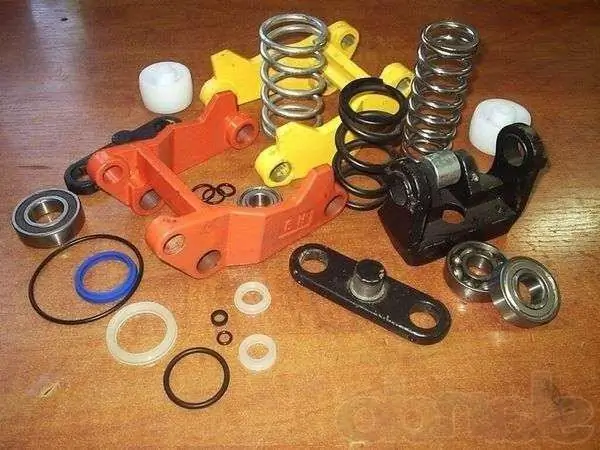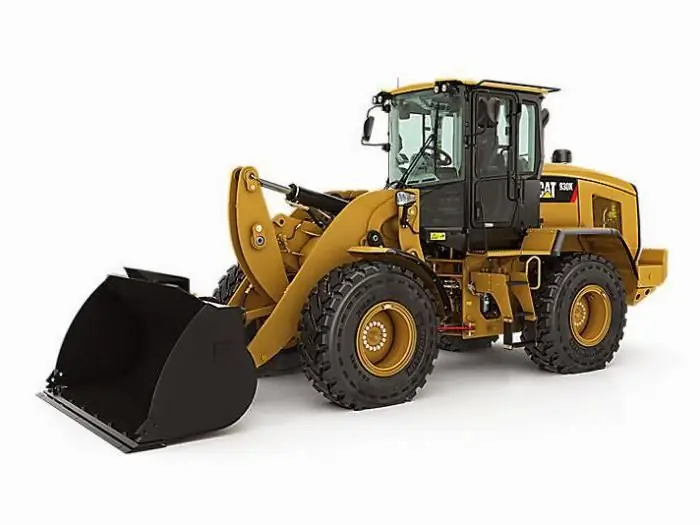2025 Author: Howard Calhoun | [email protected]. Last modified: 2025-01-24 13:10:26
A hydraulic system is a device designed to convert a small effort into a significant one using some kind of fluid to transfer energy. There are many types of nodes that operate according to this principle. The popularity of systems of this type is primarily due to their high efficiency, reliability and relative simplicity of design.

Use area
Wide use of this type of system found:
- In the industry. Very often hydraulics is an element of the design of metal-cutting machines, equipment designed for transporting products, loading / unloading them, etc.
- In the aerospace industry. Similar systems are used in various controls and chassis.
- In agriculture. It is through hydraulics that the attachments of tractors and bulldozers are usually controlled.
- In the field of cargo transportation. Cars are often equipped with hydraulicbrake system.
- In ship equipment. Hydraulics in this case is used in steering, is included in the design of the turbines.
Operation principle
Any hydraulic system works on the principle of a conventional liquid lever. The working medium supplied inside such a node (in most cases, oil) creates the same pressure at all its points. This means that with a small amount of force on a small area, you can withstand a significant load on a large one.
Next, consider the principle of operation of such a device using the example of such a unit as the hydraulic brake system of a car. The design of the latter is quite simple. Its scheme includes several cylinders (the main brake, filled with liquid, and auxiliary). All these elements are connected to each other by tubes. When the driver presses the pedal, the piston in the master cylinder moves. As a result, the liquid begins to move through the tubes and enters the auxiliary cylinders located next to the wheels. After that, braking is activated.

Design of industrial systems
The hydraulic brake of a car - the design, as you can see, is quite simple. More complex liquid devices are used in industrial machines and mechanisms. Their design may be different (depending on the scope of application). However, the circuit diagram of an industrial design hydraulic system is always the same. It usually includes the following elements:
- Reservoirfor liquid with mouth and fan.
- Coarse filter. This element is designed to remove various kinds of mechanical impurities from the fluid entering the system.
- Pump.
- Control system.
- Working cylinder.
- Two fine filters (on the supply and return lines).
- Distribution valve. This design element is designed to direct fluid to the cylinder or back to the tank.
- Return and safety valves.
The operation of the hydraulic system of industrial equipment is also based on the principle of fluid leverage. Under the influence of gravity, the oil in such a system enters the pump. Then it goes to the control valve, and then to the piston of the cylinder, creating pressure. The pump in such systems is designed not to suck the liquid, but only to move its volume. That is, the pressure is not created as a result of its work, but under the load from the piston. Below is a schematic diagram of the hydraulic system.

Advantages and disadvantages of hydraulic systems
The advantages of nodes operating on this principle include:
- The ability to move loads of large dimensions and weight with maximum accuracy.
- Virtually unlimited range of speeds.
- Smooth operation.
- Reliability and long service life. All components of such equipment can be easily protected from overloads by installing simple pressure relief valves.
- Economy inwork and small size.
In addition to the advantages, hydraulic industrial systems, of course, have certain disadvantages. These include:
- Increased risk of fire when working. Most fluids used in hydraulic systems are flammable.
- Sensitivity of equipment to contamination.
- Possibility of oil leaks, and therefore the need to eliminate them.

Calculation of hydraulic system
When designing such devices, many different factors are taken into account. These include, for example, the kinematic coefficient of viscosity of the liquid, its density, the length of the pipelines, the diameters of the rods, etc.
The main purpose of performing calculations for a device such as a hydraulic system is most often to determine:
- Pump specifications.
- Rod strokes.
- Operating pressure.
- Hydraulic performance of lines, other elements and the entire system.
The hydraulic system is calculated using various arithmetic formulas. For example, pressure losses in pipelines are defined as follows:
- The calculated length of the lines is divided by their diameter.
- The product of the density of the liquid used and the square of the average flow rate is divided by two.
- Multiply the obtained values.
- Multiply the result by the travel loss factor.
The formula itselflooks like this:
∆pi =λ x li(p): d x pV2 : 2.
In general, in this case, the calculation of losses in the lines is carried out approximately according to the same principle as in such simple structures as hydraulic heating systems. Other formulas are used to determine pump performance, stroke, etc.

Types of hydraulic systems
All such devices are divided into two main groups: open and closed type. The schematic diagram of the hydraulic system considered by us above belongs to the first variety. An open design is usually used for devices of low and medium power. In more complex closed systems, a hydraulic motor is used instead of a cylinder. The liquid enters it from the pump, and then returns to the line again.
How repairs are done
Since the hydraulic system plays a significant role in machines and mechanisms, its maintenance is often entrusted to highly qualified specialists of companies engaged in this particular type of activity. Such firms usually provide a full range of services related to the repair of special equipment and hydraulics.

Of course, in the arsenal of these companies there is all the equipment necessary for the production of such work. Repairs to hydraulic systems are usually done on site. Before it is carried out, in most cases, various diagnostic measures must be taken. For this, hydraulic service companies use special installations. The components necessary to fix problems are also usually brought by employees of such firms.
Pneumatic systems
In addition to hydraulic, pneumatic devices can be used to set in motion the nodes of various kinds of mechanisms. They work in much the same way. However, in this case, the energy of compressed air, not water, is converted into mechanical energy. Both hydraulic and pneumatic systems do their job quite effectively.

The advantage of devices of the second variety is, first of all, the absence of the need to return the working fluid back to the compressor. The advantage of hydraulic systems in comparison with pneumatic ones is that the medium in them does not overheat and does not overcool, and therefore, no additional components and parts need to be included in the circuit.
Recommended:
Hydraulic fracturing: types, calculation and technological process

Hydraulic fracturing: the essence of the technology and its detailed step-by-step description. Varieties of the process. Applied materials, their advantages and disadvantages. Acid fracturing. Equipment for hydraulic fracturing
Pneumatic high pressure pump. Pneumatic diaphragm pump

Pneumatic type pumps are in demand in various fields. There are models from different manufacturers in stores, and they will differ in parameters. In order to understand this issue, you need to consider the device of a pneumatic pump and its types
Hydraulic calculation of heat networks: concept, definition, calculation method with examples, tasks and design

It can be said that the purpose of the hydraulic calculation of the heat network at the end point is the fair distribution of heat loads between the subscribers of thermal systems. A simple principle applies here: each radiator, if necessary, that is, a larger radiator, which is designed to provide a larger volume of space heating, should receive a larger flow of coolant. This principle can be ensured by the correct calculation
Rokla, hydraulic trolley: description, device and types

The article will consider a hydraulic rokla - a universal lifting trolley that has proven itself in practice
Malfunctions and repair of hydraulic carts: features, device and recommendations

Of course, the operation of any device leads to the fact that it gradually fails. Some parts break, grease dries out, etc. All this also applies to hydraulic carts, the repair of which is quite simple, but you need to know how and when to carry it out

